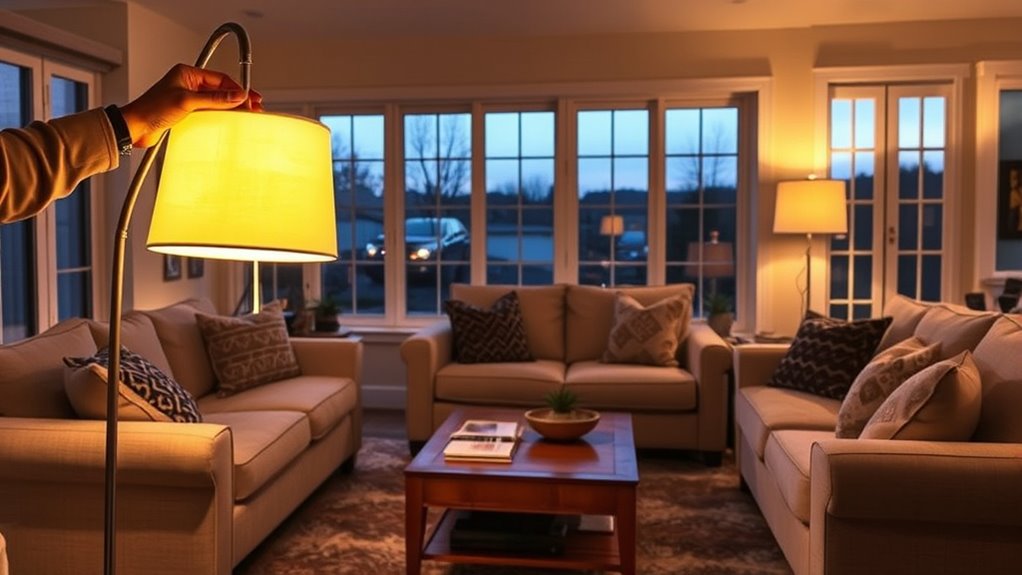To improve your home’s visibility, start by evaluating your current lighting setup and identify dark spots or overly bright areas. Choose bulbs with the right brightness and color temperature to suit different activities, such as warm tones for coziness or cooler shades for clarity. Incorporate layered lighting with ambient, task, and accent lights, and use dimmers to adjust intensity. Maximize natural light during the day by opening curtains and keeping windows clean. Keep exploring to learn more tips for brighter, more functional spaces.
Key Takeaways
- Incorporate layered lighting with ambient, task, and accent lights to improve overall visibility and reduce shadows.
- Use dimmers to adjust light brightness for different activities and enhance clarity.
- Optimize fixture placement, focusing on task areas and eliminating dark spots or glare.
- Choose bulbs with higher lumens and appropriate color temperatures to increase brightness and visual comfort.
- Maximize natural light by keeping windows clean, using reflective surfaces, and adjusting window treatments.
Assessing Your Current Lighting Setup
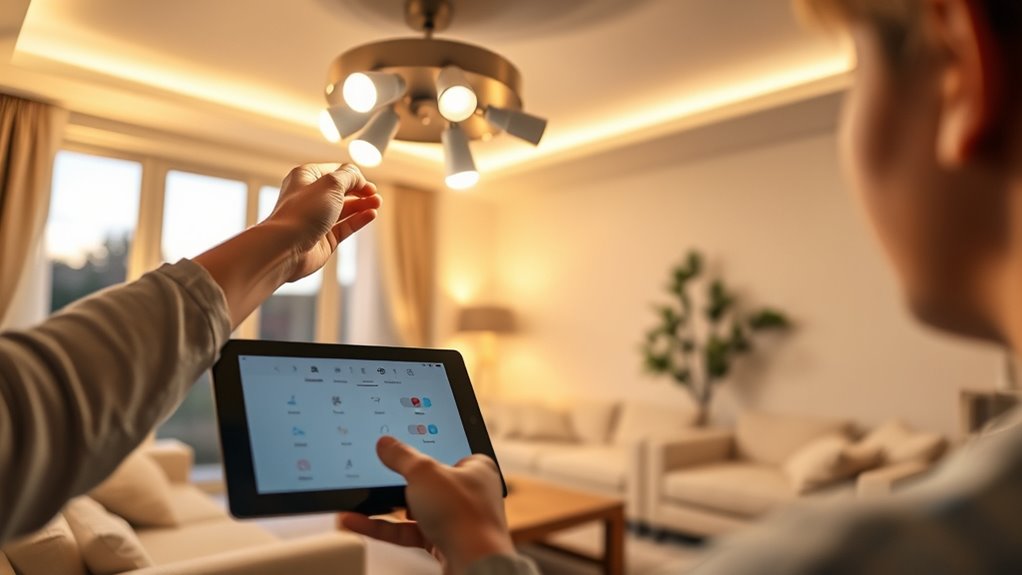
Have you ever wondered if your current lighting truly meets your needs? Start by evaluating your lighting color—does it create the ambiance you want? Warm tones can make spaces cozy, while cooler shades promote alertness. Next, evaluate your fixture styles; are they functional and matching your decor? Consider the placement of ceiling lights, sconces, and task lamps. Are they providing enough illumination where you need it most? Check if the fixtures are outdated or mismatched, which can affect both aesthetics and performance. Take note of dark corners or overly bright spots. Additionally, understanding the color temperature of your bulbs can help you optimize your lighting for various activities. Being aware of lighting quality can guide you in making better choices for your space. Furthermore, choosing the right lighting fixtures can significantly enhance the overall environment and functionality of your room. Incorporating consideration of lighting design principles can lead to more balanced and effective illumination. Considering emotional support aspects, such as lighting that creates a calming atmosphere, can also improve comfort and well-being. This initial assessment helps you identify gaps or areas needing improvement, setting the foundation for a better, more tailored lighting setup.
Choosing the Right Bulb Brightness and Color Temperature
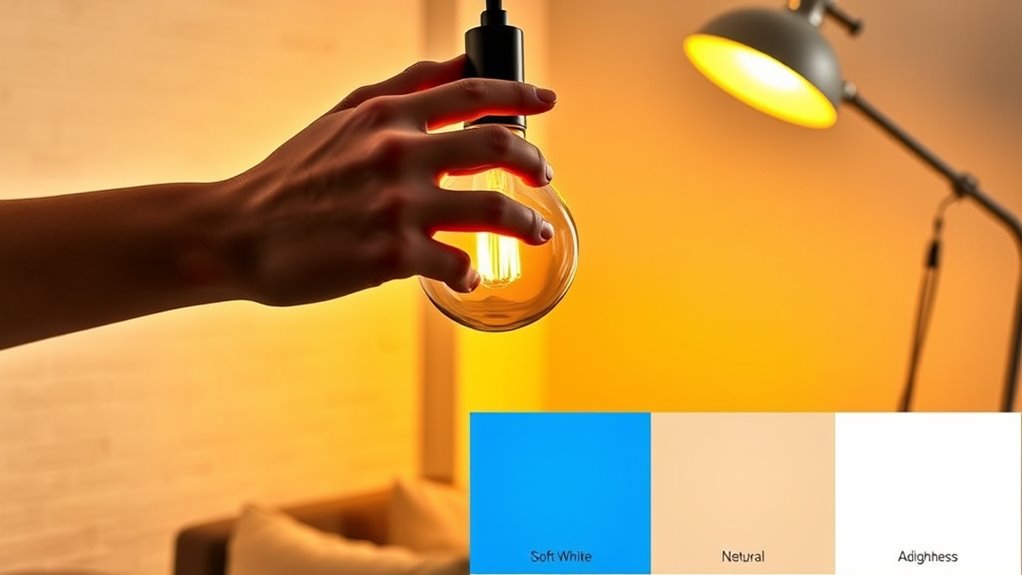
Selecting the right bulb brightness and color temperature is essential to creating a functional and inviting space. Brightness levels, measured in lumens, influence how well you see and feel in a room. For tasks like reading or cooking, opt for higher brightness, while softer light suits relaxing areas. Energy efficient bulbs, such as LEDs, help you save on electricity without sacrificing brightness. When it comes to color temperature selection, warmer tones (around 2700K-3000K) create cozy atmospheres, perfect for bedrooms and living rooms. Cooler tones (4000K-5000K) provide a crisp, invigorating light suitable for workspaces and kitchens. Understanding the balance between brightness and color temperature ensures your lighting enhances both the function and ambiance of each room. Additionally, choosing the appropriate lighting spectrum can further improve visibility and comfort. Incorporating appropriate lighting techniques can also make a significant difference in achieving the desired environment. For optimal results, consider the energy efficiency of your bulbs to reduce your overall electricity consumption and environmental impact. Moreover, selecting bulbs with the right color rendering index can enhance how colors appear under your lighting, contributing to a more natural and vibrant look.
Incorporating Layered Lighting Techniques
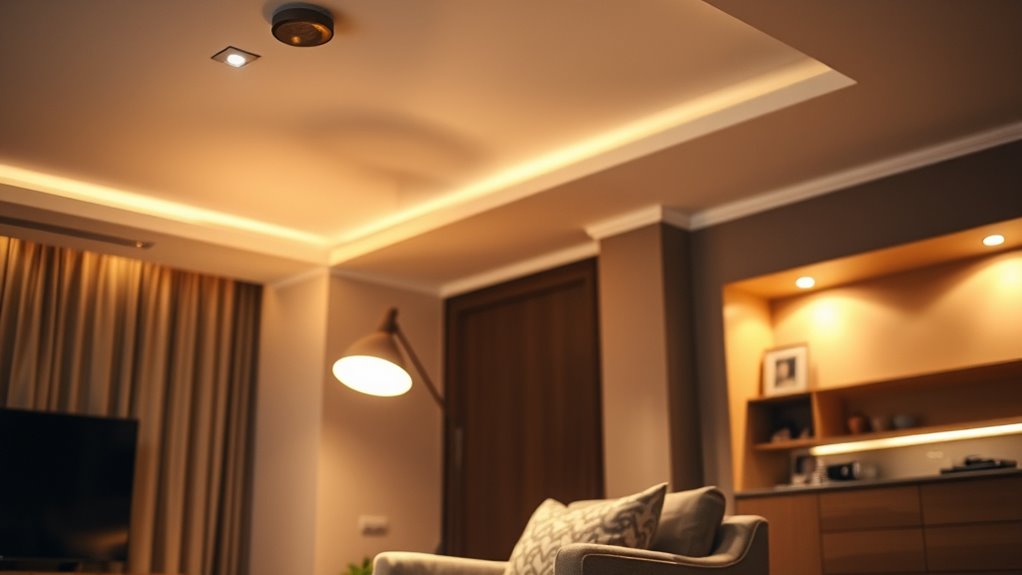
Layered lighting combines different light sources to create a balanced and versatile space. You can use dimmers to adjust the ambiance and highlight key areas with targeted lighting. By mixing various light types, you’ll achieve a functional and inviting home environment. Additionally, understanding bank opening hours can help you plan timely visits for purchasing lighting fixtures or consulting with specialists. When planning your lighting setup, consider the divorce process and requirements in Cuba to ensure that any legal or logistical considerations are addressed if relevant to your home renovation project. Being aware of credit card insights can also assist in budgeting for your lighting upgrades and managing expenses effectively. Practicing mindful decluttering strategies can help you organize your space efficiently before installing new lighting, ensuring you maximize the benefits of your improvements. Incorporating powerful persuasive words into your communication with suppliers can help you negotiate better deals and ensure you get the best value for your investment.
Combining Different Light Types
To create a well-balanced and versatile lighting scheme, combining different light types is essential. You should layer ambient, task, and accent lighting to achieve this. Using light layering guarantees each area has appropriate brightness and function. Incorporate bulbs with varying color temperatures to set the right mood and improve visibility. For example, warm tones create cozy atmospheres, while cooler tones boost alertness. Mixing these options allows you to tailor lighting to specific tasks and spaces. Be intentional about where you place different light sources, ensuring they complement each other without causing glare or shadows. Additionally, understanding cultural influences can help you select lighting that aligns with your personal or community preferences, enhancing both functionality and ambiance of your home.
Using Dimmers Effectively
Have you ever wished your lighting could adapt to different activities or moods? Dimmers are a great way to achieve that. They let you control light intensity, creating the perfect atmosphere. To use them effectively, consider these tips: 1. Adjust the light color with dimmers to match your mood—warm for cozy nights, cooler for working. 2. Place dimmable fixtures strategically, ensuring they’re near key areas like reading nooks or dining tables for flexibility. 3. Use dimmers with layered lighting, combining ambient, task, and accent lights for a balanced look. 4. Test different brightness levels to find what feels right, avoiding overly harsh or dull lighting. 5. Incorporate water-based lighting elements, such as illuminated fountains or aquariums, to add unique visual effects and enhance the ambiance. Additionally, layered lighting techniques help you create a more versatile and inviting space by combining multiple light sources for optimal functionality and atmosphere. With thoughtful fixture placement and attention to light color, dimmers help you customize your space effortlessly. Implementing air purifiers can also contribute to a healthier environment, making your space not only more beautiful but also more comfortable and healthful.
Highlighting Key Areas
Are you making the most of your home’s lighting by emphasizing key areas? Layered lighting techniques help you do just that. Use a combination of ambient, task, and accent lighting to highlight focal points and create depth. Incorporate decorative accents like wall sconces or picture lights to draw attention to artwork or architectural features. Proper placement of light sources can cast ambient shadows, adding dimension to your space. Focus on illuminating areas where you spend the most time, like the living room or kitchen counters, while keeping other zones subtly lit. This approach not only improves visibility but also enhances the room’s ambiance, making your home feel more inviting and well-designed. Understanding interior design involves more technical planning and structural considerations, which can influence your lighting choices. Paying attention to lighting quality ensures a comfortable and visually appealing environment. Additionally, considering interior design basics can help you plan your lighting setup more effectively. Moreover, selecting the right home decor elements can further enhance the overall aesthetic and functionality of your lighting scheme. Incorporating layered lighting techniques allows for greater flexibility in adjusting the atmosphere to suit different moods and activities.
Using Dimmers to Adjust Light Intensity
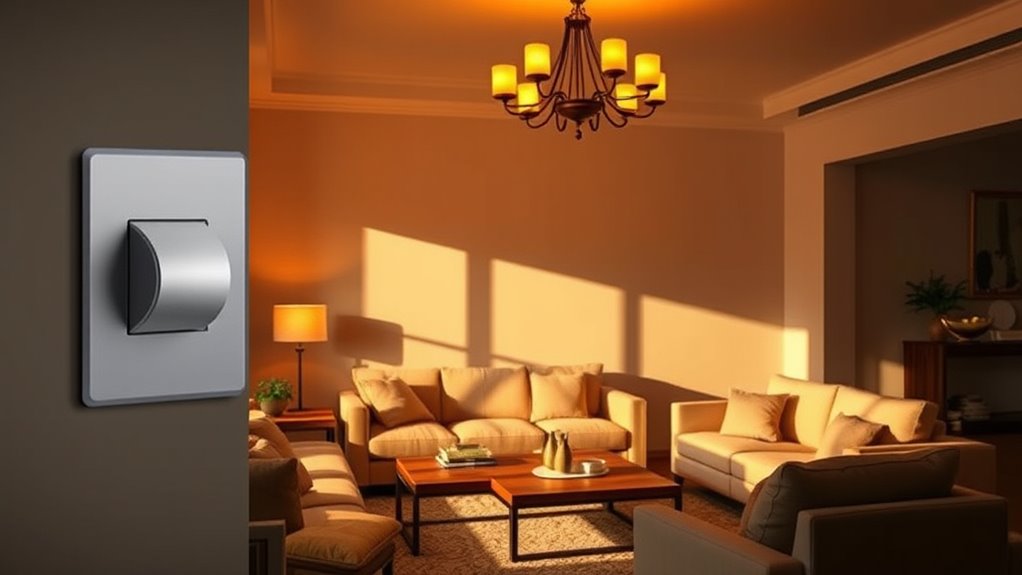
Dimmers give you control over your lighting, helping create the perfect mood while conserving energy. You can choose from different types of dimmer switches to suit your fixtures and preferences. Installing and using them correctly ensures smooth operation and long-lasting performance.
Benefits of Dimming Lights
Adjusting light intensity with dimmers offers a range of benefits that can enhance your living space. Dimming improves lighting aesthetics by creating the perfect ambiance for any activity or mood. It also helps you save energy by reducing energy consumption, which lowers your electricity bills. Additionally, dimmers give you more control over your environment, allowing you to customize brightness levels easily. Incorporating energy-efficient lighting features further maximizes these benefits by reducing overall power usage. With the rise of smart home technology, you can now automate and fine-tune your lighting to suit your preferences even more precisely.
Types of Dimmer Switches
There are several types of dimmer switches available, each designed to suit different lighting needs and fixture types. Understanding the various dimmer switch types helps you choose the right one for your home. For example, rotary dimmers are traditional and easy to use, while slide dimmers offer precise control. Modern options include digital dimmers that connect with smart home systems. When selecting a dimmer switch, wiring compatibility is vital; some dimmers are designed for specific bulb types or wiring setups. Incandescent dimmers typically work with standard wiring, but LED-compatible dimmers are necessary for energy-efficient bulbs. Always verify that the dimmer switch type matches your fixtures and wiring to guarantee safe and efficient operation. This knowledge helps you create the perfect ambiance in any room.
Installation and Usage Tips
To effectively use dimmers to control light intensity, start by ensuring they are properly installed and compatible with your fixtures and bulbs. This is especially important for decorative fixtures and creating ambient settings. Once installed, follow these tips:
- Always test the dimmer with your specific bulbs to avoid flickering or buzzing.
- Use dimmers with adjustable range settings for precise control over ambient lighting.
- Dim the lights gradually to find the perfect mood without sudden brightness changes.
- Turn off the dimmer when not in use to prolong its lifespan and prevent electrical issues.
Proper installation and thoughtful use help you customize lighting for any room, enhancing ambiance and visual comfort while protecting your decorative fixtures.
Optimizing Natural Light During Daytime
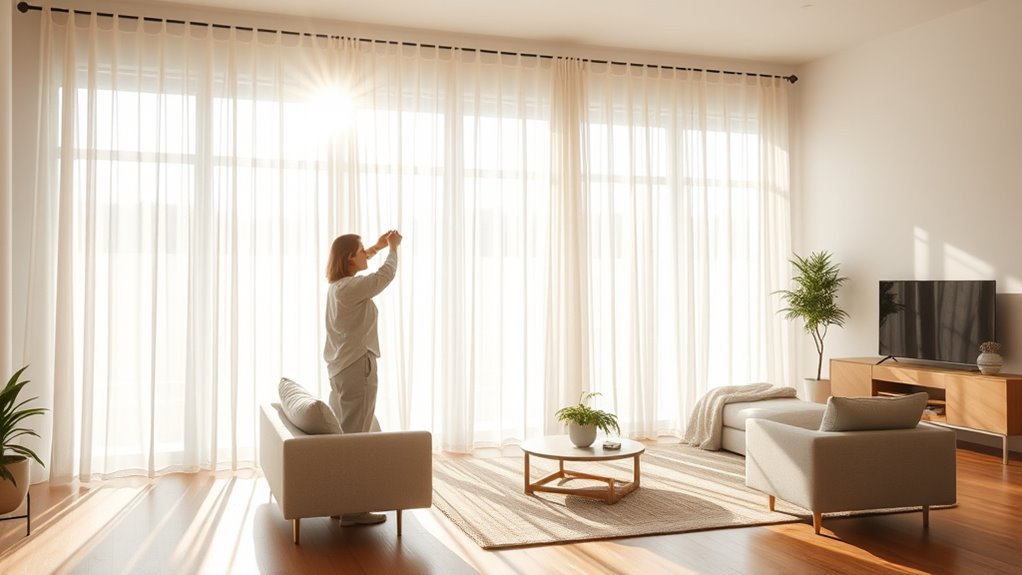
Maximizing natural light during the day can substantially enhance your home’s ambiance and energy efficiency. Start by choosing the right window treatments, like light-colored curtains or blinds that can be easily adjusted to control sunlight without blocking views. Keep windows clean to let in the maximum amount of light and consider installing reflective surfaces nearby to bounce light deeper into rooms. Use outdoor lighting strategically; trimming trees or bushes that shade windows allows more sunlight to enter. Open curtains and blinds early in the day to flood your space with natural brightness. By managing window treatments and outdoor lighting, you create a brighter, more inviting environment while reducing reliance on artificial lighting during daylight hours.
Positioning Fixtures for Maximum Effectiveness
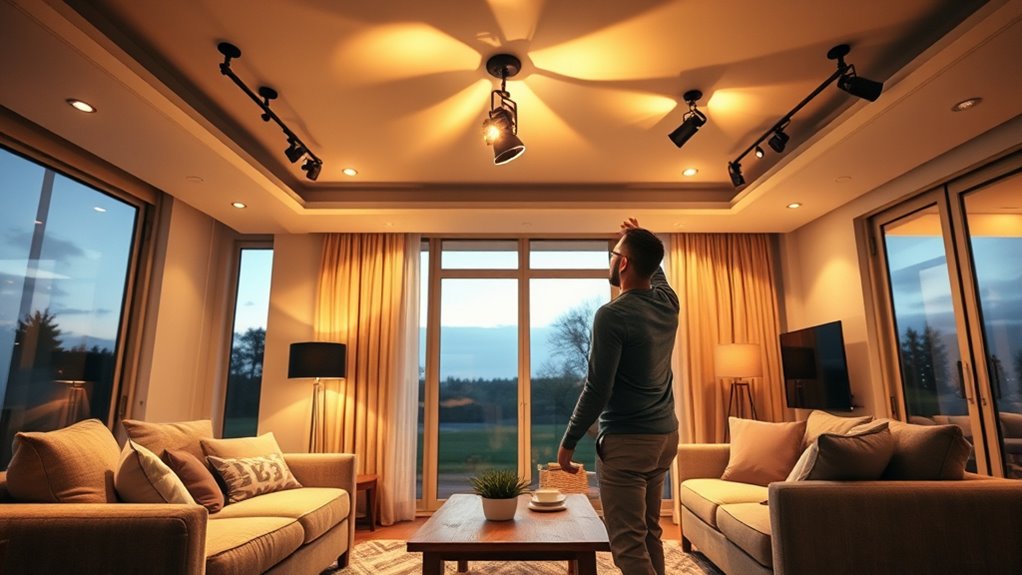
Strategically positioning your light fixtures is key to achieving ideal illumination throughout your home. Correct fixture placement and light positioning guarantee every area is well-lit and comfortable. Here are some tips:
- Place fixtures near corners to eliminate shadows and distribute light evenly.
- Use adjustable fixtures to direct light where it’s needed most.
- Mount ceiling lights centrally for balanced illumination across rooms.
- Avoid placing lights directly behind furniture or artwork, which can block light and create dark spots.
Utilizing Task Lighting for Specific Activities
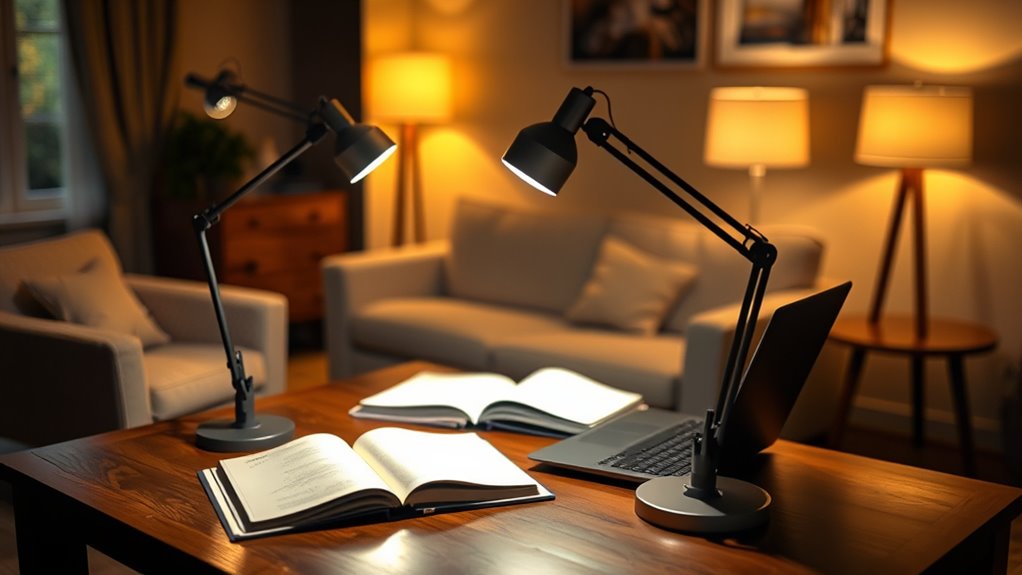
Effective fixture placement can considerably enhance your home’s functionality by providing focused lighting where you need it most. Use task lighting, such as adjustable desk lamps or under-cabinet lights, to brighten specific areas for activities like reading, cooking, or working. Incorporate decorative fixtures to add style while serving a practical purpose. Choose energy-efficient bulbs to reduce electricity consumption without sacrificing brightness. Position these fixtures directly where illumination is needed, avoiding shadows or glare. For example, placing a dedicated light over your kitchen counter makes meal prep safer and easier. In your workspace, targeted lighting minimizes eye strain. Prioritizing task lighting not only improves visibility but also helps you save energy, making your home more comfortable and efficient.
Implementing Smart Lighting Solutions
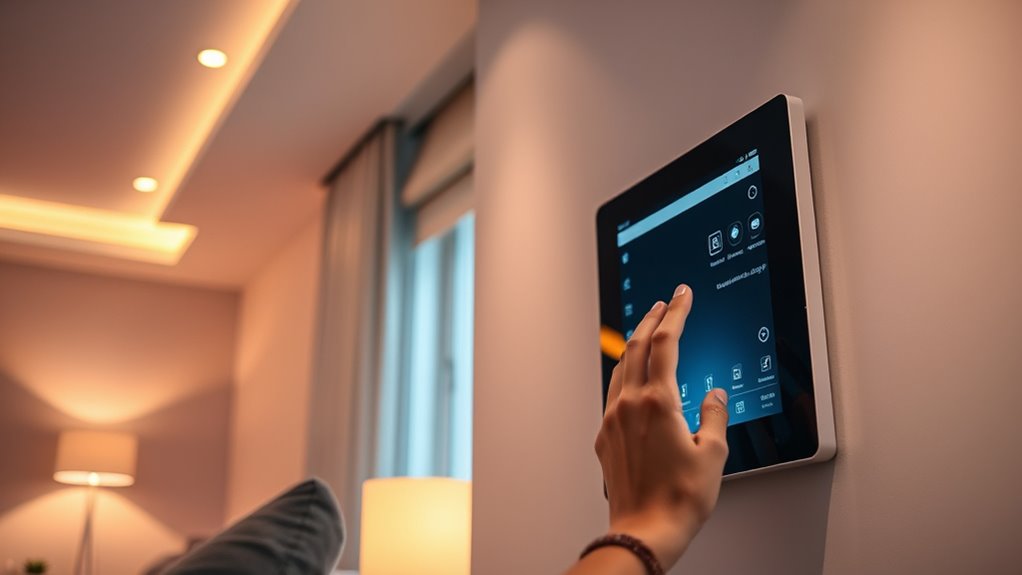
Implementing smart lighting solutions can transform the way you manage and customize your home’s illumination. With voice control, you can turn lights on or off, dim, or change colors effortlessly, making adjustments simple and hands-free. Smart lighting also boosts energy efficiency by automatically adjusting brightness based on your schedule or natural light levels. Here are some ways to get started:
- Connect smart bulbs or switches to your Wi-Fi network.
- Use voice commands with virtual assistants like Alexa or Google Assistant.
- Create schedules to turn lights on/off during specific times.
- Use apps to customize lighting scenes for different moods or activities.
These features help you save energy while enhancing comfort and convenience in your daily life.
Regular Maintenance and Upgrades for Consistent Visibility
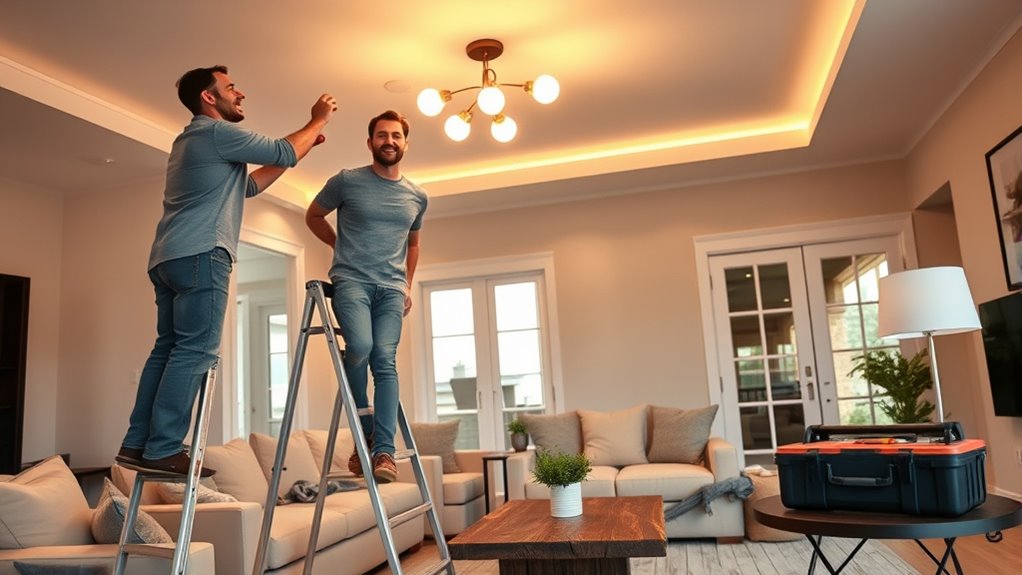
To guarantee your home’s lighting remains bright and reliable, regular maintenance and timely upgrades are essential. Check your decorative fixtures regularly for dust, dirt, and any signs of damage, and clean or replace them as needed. Upgrading to energy-efficient bulbs can considerably reduce energy consumption while maintaining ideal brightness. Consider replacing outdated fixtures with modern designs that enhance your space’s aesthetics and functionality. Keep your wiring and switches in good condition to prevent flickering or outages. Periodically review your lighting plan to identify areas needing improved visibility. Updating fixtures and bulbs ensures consistent illumination, saving energy and enhancing safety. Regular upkeep guarantees your lighting remains effective, welcoming, and visually appealing, making your home brighter and more comfortable every day.
Frequently Asked Questions
How Can I Prevent Glare and Reflections in My Home Lighting?
To prevent glare and reflections in your home, focus on glare reduction and reflection control. Use matte or satin finishes on walls and furniture to diffuse light, and position light sources away from screens or reflective surfaces. Opt for adjustable lighting fixtures and dimmers to control brightness levels. You can also use lampshades and indirect lighting to minimize harsh light, creating a more comfortable environment with less glare and fewer reflections.
What Are the Best Lighting Options for Energy Efficiency?
When choosing energy-efficient lighting, you want options that save power, last longer, and offer versatility. LED fixtures stand out because they consume less energy, emit less heat, and have a longer lifespan. Smart bulbs add convenience, allowing you to control brightness and color remotely, schedule lighting, and reduce unnecessary usage. Combining LED fixtures and smart bulbs helps you cut costs, enhance control, and create a more sustainable, efficient home environment.
How Do I Choose Lighting That Complements My Décor?
When choosing lighting that complements your décor, focus on decor matching and style harmony. Consider your room’s color palette, furniture, and overall theme. Opt for fixtures that enhance your style—modern, rustic, or vintage—and match your décor’s tones and textures. This creates a cohesive look and highlights your space’s personality. By selecting lighting that aligns with your décor, you guarantee a harmonious environment that feels inviting and well-designed.
Can Color-Changing Lights Improve Mood and Visibility?
Color-changing lights can definitely enhance your mood and improve lighting ambiance. By adjusting the color mood, you create a space that feels more relaxing or energizing, depending on your needs. These lights let you customize your environment easily, making it more inviting and comfortable. Whether you want soft, warm tones for relaxation or vibrant colors for activity, color-changing lights give you versatile control over your home’s atmosphere.
What Safety Precautions Should I Consider With New Lighting Installations?
This is as vital as defusing a bomb—safety first! When installing new lighting, focus on electrical safety to prevent shocks or fires. Make certain fixtures are securely mounted to avoid accidents, especially in high-traffic areas. Turn off power at the breaker before working, and double-check connections. If unsure, hire a professional. Prioritizing safety guarantees your new lighting brightens your space without risking your home’s security.
Conclusion
Think of your home lighting as a symphony—you’re the conductor. By evaluating your setup, choosing the right bulbs, layering lights, and embracing smart solutions, you create harmony and clarity. Regular tune-ups keep everything shining brightly. When you fine-tune your lighting, your space becomes a stage where every detail stands out, and every moment is clear. Take control, and let your home glow with confidence, turning everyday living into a masterpiece.
